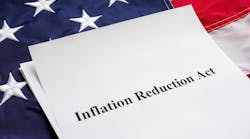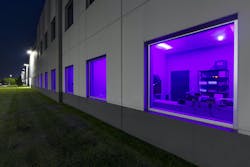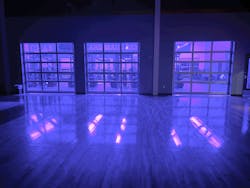The Inflation Reduction Act (IRA) and the Infrastructure Investment Jobs Act (IIJA) are two federal laws that present tremendous opportunities for implementing energy-efficient upgrades, such as new interior lighting systems. However, given the intricacies of these laws, understanding how you can counsel clients to take advantage of them for their next project may be daunting. As we come to the end of the year, it’s the perfect time to break down the laws’ details as they pertain to both tax-exempt and for-profit organizations, review what projects qualify, examine funding sources, and determine the next steps.
IRA and IIJA unpacked
The IRA directs nearly $400 billion in federal funding to clean energy, with the goal of substantially lowering the nation’s carbon emissions by the end of this decade. The funds are being delivered through a mix of tax incentives, grants, and loan guarantees.
The IRA is significant for many reasons, not the least of which is that it opens up investment and development opportunities driven by tax credits for tax-exempt organizations, such as K-12 school districts, higher education institutions, and hospitals, that were previously unavailable. Before this bill was passed, tax credits were generally only applicable to entities such as for-profit corporations that had taxable income to offset. The IRA solves that problem with a new approach to tax credit incentives that is a game-changer for tax-exempt entities. Additionally, the law includes a new direct pay provision that allows tax-exempt entities to monetize applicable tax credits. Exempt organizations can now treat earned tax credits as an “overpayment of taxes” and receive a direct payment from the U.S. Treasury as a tax refund.
For tax-exempt entities, the IRA direct pay option alleviates a longtime obstacle to participating in climate-friendly activities encouraged by these credits. Before the IRA’s direct pay option, it was more expensive for tax-exempt organizations to take advantage of energy-saving technologies than for-profit taxpayers because tax-exempt organizations generally have little or no tax to offset against tax credits.
Specifically for tax-exempt organizations, the IIJA is another equally significant law that provides $550 billion in federal spending allocated over the next five years. The historic investments include projects ranging from clean energy to broadband and are significantly reframing infrastructure in the United States while also supporting schools and tax-exempt organizations to make critical energy upgrades. Funding for IIJA is through grants and loans, and some examples are included in this article.
Project eligibility and tax incentives
Both businesses and tax-exempt organizations can now benefit from Section 179D Energy Efficient Commercial Buildings Tax Deduction for energy-efficient projects. In addition to using Section 179D deductions, companies can use tax credits for upgrades or construction projects. Specifically, Section 148 Investment Tax Credit (ITC) allows building owners to use the tax credit against their tax liability. In most cases, the credits now carry back three years and forward 20 years. If the owner(s) doesn’t have tax liability or taxable income, then certain credits may be sold to another taxpayer. This concept is known as transferability.
The IRA established a new elective retrofit program as an alternative deduction for energy-efficient building retrofits, which is taken in the qualifying final certification year. The alternative deduction requires a qualified retrofit plan and is focused on energy use intensity rather than total annual energy and power costs. The alternative deduction cannot exceed the aggregate adjusted basis of retrofit property placed in service.
Most of the IRA tax credits are available through 2032, according to Baker Tilly, but it is important to note that both current and future construction projects may be credit eligible. The date construction begins and the date the property is ultimately placed in service are both critical in determining whether the project is eligible for enhanced credit opportunities. It is necessary to carefully review the type of credit being claimed and the requirements specific to that credit.
If your clients are considering renovations or new construction projects, both qualify for the 179D deduction. Additions such as a school’s new library or a hospital’s new wing qualify based on the efficiency of only the addition, not the efficiency of the entire/existing structure. The IRA changes to 179D removed the partial deduction related to the separate systems, so the deduction is always based on the efficiency of the project as a whole.
Buildings that increase their energy efficiency by at least 25% will be able to claim this deduction, with bonuses for higher efficiency improvements. The higher level of incentive for large savings is designed to encourage “zero energy ready” projects. In addition, owners can earn 179D benefits every three to four years, as long as a new capital event has led to additional reductions in the building’s carbon footprint.
Qualifying lighting upgrades
Improving a building’s energy efficiency creates long-term savings that go straight to the bottom line. But the upgrades can sometimes be costly. Now, with the passage of the IRA, commercial real estate property owners and designers have additional incentives available when making energy-efficient improvements. While there are inherent savings to upgrading interior lighting from legacy metal halide fixtures to new, energy-efficient LEDs — over 60% in energy consumption, reduced maintenance costs, and lower overall heat in the facility — the rebates and incentives from the IRA and Section 179D tax code offer even more reasons to move forward with these projects.
The types of qualifying buildings include:
- Retail
- Office
- Industrial
- Warehouses
- Government-owned (city, state, or federal) buildings including schools, airports, town halls, and state colleges for example.
- Apartment buildings greater than four stories
A typical example of 95,000 square-foot warehouse lighting upgrade:
- Cost of doing LED upgrade: $63,000
- Utility rebate: $24,000
- Total cost (after utility rebate): $38,000
Retrofits can qualify by demonstrating a 25% decrease in energy use intensity (measured in BTUs) compared to the pre-retrofit building. A qualified retrofit plan is required, and the building must have been placed in service at least five years before producing this plan. The deduction must be taken in the year of final qualifying certification.
The revised tax code offers a strong incentive to stretch energy efficiency in new buildings and modernize existing buildings. In new buildings, it incentivizes more detailed design and the most advanced control options. In existing buildings, it incentivizes a wide range of lighting and advanced control options that, when coupled with available utility rebates, can substantially reduce initial cost, which remains the largest inhibitor to investment in reducing operating costs via energy efficiency.
Funding opportunities
Building-related tax incentives make up about 14% of the total clean energy-related resources in the IRA. The IRA provides many tax credit opportunities — even for tax-exempt organizations. In addition to these tax credits and the IRA’s changes to the 179D Energy Efficient Commercial Buildings Tax Deduction, organizations have other sources to help offset the costs of energy upgrades, new construction, and renovations. The following are a few funding opportunities from both the IRA and IIJA, broken down by tax-exempt and/or for-profit options.
Applicable to both
- Greenhouse Gas Reduction Fund provides grants to support technical and financial assistance to reduce greenhouse gas emissions, functioning essentially as a national green bank. The U.S. Environmental Protection Agency is administering this $27 billion program, and funding started in February 2023 and runs through September 2024. The fund sets aside $15 billion specifically targeting low-income and disadvantaged communities.
Tax-exempt organizations
- Nonprofit Energy Efficiency Materials Pilot Program (IIJA Sec. 40542) offers $50M through 2026 for this Department of Energy (DOE) pilot program providing nonprofits with grants of up to $200,000 for energy improvements in buildings, including lighting. Through this pilot program, the DOE identifies scalable models for energy efficiency retrofits in both the nonprofit and commercial sectors.
- Renew America's School grant program facilitates substantial additional investment that intends to prioritize schools with high needs. The program is designed to minimize administrative burden and build enduring capacity in local educational agencies and the states to maximize impact equity and efficiency. From keeping schools open to investing in infrastructure, this fund provides financial assistance for a variety of necessary projects to school districts across the country.
- Grants for Energy Efficiency Improvements and Renewable Energy Improvements at Public School Facilities (IIJA Sec. 40541). The goal of this competitive grant program is to finance the use of clean energy and improvements in energy efficiency/indoor air quality, in schools. These enhancements to school buildings support lower carbon emissions and promote student health. Relevant eligible beneficiaries might be: A consortium of at least one local education agency and at least one school, nonprofit organization, for-profit organization, or community partner.
- Eligible improvements covered by these grants include those that result in school energy cost reductions, energy savings, and health improvements.
- Priority given to schools serving low-income communities that have the greatest renovation, repair, and improvement funding needs, and that can leverage private sector investment through energy-related performance contracting.
- Public School Facilities Grants (IIJA Sec. 40541) are competitive grants to schools and partner organizations (nonprofit and for-profit) over five years (2022-2026) for clean energy improvements at K-12 schools with priority to schools with renovation/repair needs, lower-income schools, and schools using energy-related performance contracting.
For-profit organizations
- Property Assessed Clean Energy (PACE) is a financing tool that allows property owners to finance the upfront cost for qualified energy, water, resilience, and public benefit projects with funding through a voluntary assessment on the property tax bill. The local government typically acts as the payment collector and remitter. One of the main benefits of PACE for property owners is that it can be used to cover 100% of the upfront cost of an energy or resilience upgrade. The investments are then repaid over the useful life of the installed equipment. The longer payback period (and lower annual or semi-annual payments) can make upgrades more affordable for property owners.
Timing
To qualify for deductions, energy efficient upgrade projects must begin by Dec. 31, 2024 and be completed by Dec. 31, 2028. If the project starts after December 31, 2024, or finishes after December 31, 2028, then it must be carbon neutral. When considering projects that involve grants or loans due to the many government agencies involved in overseeing these, application deadlines vary. Turn to a trusted partner in navigating these resources to help you take advantage of the opportunities they present.
Trusted advisor
While these laws can be challenging to navigate, understanding the IRA and IIJA — and how they are available for your clients’ lighting upgrades — positions you as an honest broker and resource. There is no time like the present to begin the planning process for upcoming projects with these tax incentives and federal funding resources as catalysts.







